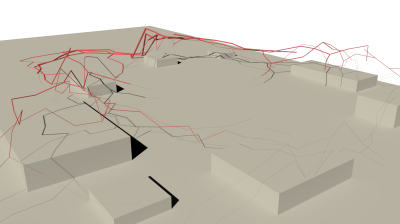project07:W3
Ori Gilboa
For my project of urban-cinema I tried to establish a well connected building which reacts and response to the environment and to its surroundings. It was highly important to allow a parametric, flexible pathways from a central point. A root or a plant may serve as an allegory for this type of branching structure. I was contemplating 3 strategies: Agent-base design (swarm behavior), L-systems and recursive systems. Agent-base design is responsive and can create an elaborate forms, however it is a decentralize system, and has no hierarchy. L systems contain a good thematic branch algorithm and hierarchy - but they are tend to be too rigid and uninfected by the surroundings. Recursive systems respond to the environment - and can have a hierarchy. This was my base strategy for the beginning.
I planned the algorithm according to 3 layers:
base branching: The branching starts from a central point. It has a certain direction (generated from a field of randomness) and characteristic: number of nodes (or branching points), length of branches, minimum distances from one node to the other.
Polygon borders: Borders are defined by closed polygons. The branching algorithm avoids going into any of them. For every placed node a check is being made to make sure it is within "safe zone" - if it does, it stays, otherwise - it is deleted. Those borders could be used as the perimeter of the site, open spaces or unapproachable obstacles.
